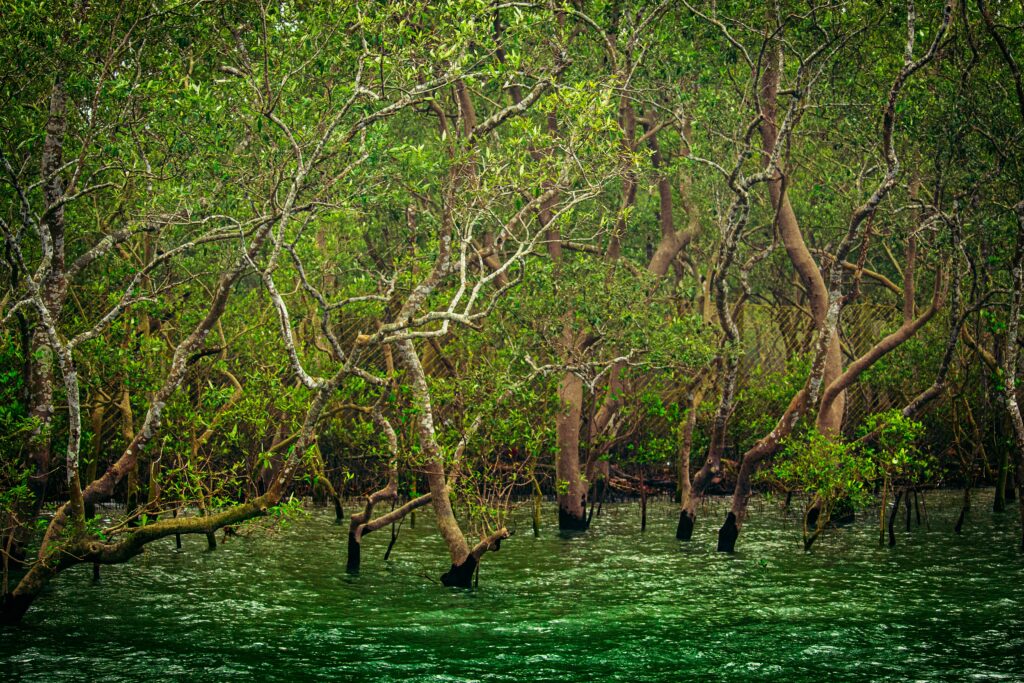Conserving urban wetlands and integrating them into communities is extremely crucial for India’s carbon sequestration and climate resilience goals. This requires a new imagination of ‘nature’ as something that exists within cities and integrated with communities rather than a ring-fenced and protected site away from all human engagement. As rapid urban growth increasingly encroaches on natural ecosystems, it is important to bring nature into our cities through planning and conservation. Urban wetlands – which have so far been ignored in conservation policies – can be crucial sites for biodiversity protection and a powerful tool for climate resilience and net-zero goals of a city.
Wetland ecosystems in Indian cities are often treated as wastelands. They are used as dumping grounds for industrial chemicals, household waste and untreated sewage, while at the same time they are also threatened by urban expansion and encroachment Every city and town in India has several polluted wetlands that are further deteriorating day-by-day and yet there seems to be very little emphasis on reviving them. Nearly 30% of natural wetlands[1] have been lost in India in the last three decades with Indian cities suffering the most due to rapid urban expansion, inefficient waste management and most importantly, lack of serious efforts in conserving them. The Karnataka revenue minister recently stated in the Legislative Assembly that Bangalore has lost 42 lakes in the last few decades [2], Chennai’s water bodies have shrunk due to urbanization[3] and nearly 500 water bodies in Delhi have vanished due to garbage dumping, but are now being revived by the Delhi Government[4].
Urban wetlands can be very beneficial for Indian cities as they can fulfill several important functions such as providing a natural environment for efficient carbon sequestration, improving the quality of surface water, and creating much-needed recreational areas for city dwellers. They also act as sponges for rainwater and play an important role in flood control while contributing heavily towards groundwater recharge. Wetlands can blunt the force of major storms resulting in reduced coastal erosion and damage to individual properties, which can be crucial for Indian coastal cities.
Wetlands can also provide increased resilience to extreme weather events for local communities – which is the need-of-the-hour for many Indian cities which are grappling with floods during monsoon season. Wetlands contain about 12% of the global carbon pool and coastal wetlands sequester carbon up to 55 times faster than tropical rainforests.[5] In order to achieve net-zero carbon goals for Indian urban centers, reviving and conserving wetlands within city premises may be the most efficient tool for urban planners.
Looking Beyond Ramsar Sites
India is one of the Contracting Parties to Ramsar Convention, which is a treaty for the conservation of wetlands, signed in Ramsar, Iran, in 1971. From the time India signed it in 1982, the country has added several new wetlands to the list of Ramsar sites. In 2022, the list reached a total of 75 Ramsar sites covering an area of 13,26,677 hectares of land, coinciding with India’s 75th year of Independence. Along with Ramsar Convention, the national Plan for Conservation of Aquatic Ecosystems (NCPA) of the Ministry of Environment, Forest and Climate Change (MoEFCC) and Wetlands (Conservation and Management) Rules, 2017 – all recognise the importance of wetlands and the need for their wise-use strategy along with fostering nature-culture relationships at the Ramsar sites.
Unfortunately, these conservation efforts for Indian wetlands are centered primarily on the 75 Ramsar sites but there are many unrecognized wetlands, especially in cities, which are woefully ignored making them open to encroachments and pollution. According to the National Wetlands Atlas 2021 by MoEFCC, there are over 750,000 wetlands in India which are spread over 1,52,60,000 hectares of land out of which Ramsar sites constitute only around 9% of the wetlands. The focus must shift towards urban wetlands setting a precedent for conservation within city premises.
Nature-Culture Relationship Around Urban Wetlands
The current imagination of Nature – and by extension, conservation- is that it needs to be protected from human activity by designating them as protected sites. While it may be an effective strategy in remote areas with fewer populations, this approach cannot work in urban spaces. In this age of rapid urban expansion and high population density, nature must be imagined within our city premises, and citizens must actively be made stakeholders in protecting these ecosystems. By bringing inclusive and participatory approaches, it is perhaps our best shot at conserving wetlands in cities.
This also forces city administrations and urban local bodies to address issues connected to them – such as waste management, urban agriculture, sewage treatment, rainwater harvesting, biodiversity protection etc. Furthermore, there is a rise in artificial wetlands[6] which can also be promoted in growing mid-sized cities in India and integrated with other community-based initiatives. This requires a strong emphasis on behavioral change towards caring for nature.
In this regard, the Wetlands of India portal, which is a knowledge repository for wetlands by the Ministry of Environment, Forest and Climate Change (MoEF&CC) could be an essential engagement tool. City administrations and state governments can collaborate with the ministry and engage in knowledge exchange programmes regarding wetland ecosystems and collaborate further on their conservation and management.

Cities Must Take the Lead
It is in the interest of city administrations and their respective state governments to take lead on conservation work around urban wetlands. Working closely and in collaboration with the Ministry of Environment, Forest and Climate Change (MoEF&CC), the city administrations can imagine the implementation of wetland conservation and protection with a wide range of stakeholders while promoting active citizen participation. Public awareness programmes can also integrate ecological, cultural and historical resources associated with the wetland ecosystems.
Urban local bodies will play a crucial role in implementing this at a city level as they are also responsible for implementing waste management systems, sewage treatment plants and creation of local parks for its residents. All these efforts must be reflected in city planning especially in growing mid-sized cities as there is room for integration.
Wetlands are considered to be among the most productive ecosystems on earth and provide habitat for many species of migratory birds, mammals, fish and amphibians. Large animals such as Nilgai, deer, wild cats and many other endangered species may utilize these wetlands in urban spaces. It is therefore crucial that the city administrations create wildlife corridors within city premises so that the human-animals can coexist peacefully and have access to natural resources such as lakes, marshes, forests and grasslands. Urban farming can also be promoted by carefully utilizing natural resources associated with wetlands while keeping in mind the ecological sensitivity of the area.
Finally, wetlands have enormous value to the lives of individuals, communities and nations. Sectors that depend on wetlands such as fishing, tourism, agriculture, water transport, handicrafts and aquaculture can contribute to the economy of the nation along with providing millions with livelihood opportunities.
This article was originally published on Wire Science.
References:
[1] https://south-asia.wetlands.org/news/join-us-to-celebrate-world-wetlands-day-2023/
[2] https://www.thehindu.com/news/cities/bangalore/42-lakes-have-disappeared-in-bengaluru-says-ashok/article65909800.ece
[3] https://ic-sd.org/wp-content/uploads/2020/11/Bhrigu-Kalia.pdf
[4] https://ddc.delhi.gov.in/delhi-2047/current-projects/city-of-lakes
[5] https://www.unep.org/news-and-stories/speech/wetlands-important-tool-build-resilience
[6] https://www.frontiersin.org/articles/10.3389/fbuil.2021.777383/full




